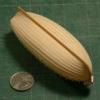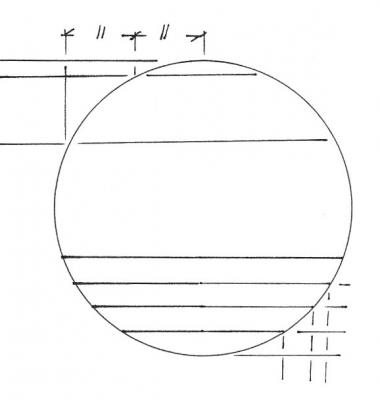-
Posts
13,177 -
Joined
-
Last visited
Content Type
Profiles
Forums
Gallery
Events
Everything posted by druxey
-
Michael: the OED cites 'rhoding' from naval architecture books, 1850,(which is very late) but, alas, gives no origin as to its meaning.
-
Sometimes headroom in the great cabin was improved by progressively raising the deck clamp aft, relative to the deck below. I suppose it might be possible that deck beams were of decreasing radius to achieve a similar result. However, that would be far more complex and time consuming. It seems unlikely, but one never knows….
-
So, the gauntlet has been picked up! I'll look forward to seeing the result. Good move, sir.
- 1,207 replies
-
- sloop
- kingfisher
-
(and 1 more)
Tagged with:
-
It's expensive, but front-silvered glass eliminates that 'gap' in a mirrored half model. A possible help for rigging of the earlier period might be to look at blocks recovered from Mary Rose. They are certainly different than 18th century or modern blocks. OK, they are not as early as your model, but might give some useful pointers anyway. Lovely work, Dick.
-
The fallacy in your argument, Mark, is assuming that the round up is directly proportional to the with of the beam. A moment's thought will tell you this is not so. As the beam narrows, the 'fall off' of the round up is quite small. The wider the chord of the circle (i.e the width of the beam), the more rapid the increase in round up. In the upper half of the illustration, twice the beam width is not twice the round up! The corollary of this idea is shown in the lower half. Hopefully this clears up your dilemma.
-
Not that I wish to influence you in any way, Remco, but a) a brick hearth would look really interesting and different and I'm sure you could make a superb one. (He walks away, whistling nonchalantly…)
- 1,207 replies
-
- sloop
- kingfisher
-
(and 1 more)
Tagged with:
-
Mark: if you can find good linen line without slubs in it, either keep the source secret or just share it with me! Seriously, it's nearly impossible to find that quality any more.
- 728 replies
-
- le fleuron
- 64 gun
-
(and 1 more)
Tagged with:
-
Congratulations on your new project, Ben. You are off to a fine start.
- 889 replies
-
It looks as if the lower deck was lowered forward to accommodate the galley. The notation on the drawing suggests that draught is very close to the 'as built' for Swan and Kingfisher. Remember that these two ships were the leading ones of this class, so the earlier type of galley would make sense here. It's a nice variation on the Swan theme - or is that the swan-song?
- 1,207 replies
-
- sloop
- kingfisher
-
(and 1 more)
Tagged with:
-
It's a nice compliment to your research and drafting that you are getting these requests, E&T. Do I also sniff a book in the making?
- 346 replies
-
- terror
- polar exploration
-
(and 2 more)
Tagged with:
-
Fire hearth is what occurred to me also, seeing the 'U' shaped layout. As this was an extremely heavy item with its brickwork, etc, it makes sense that it would be placed lower in the ship that the conventional Brodie style stove. I concur with Gary. Also, the steam funnel would be necessary to vent the area in addition to the hearth's flue for smoke.
- 1,207 replies
-
- sloop
- kingfisher
-
(and 1 more)
Tagged with:
-

ROYAL CAROLINE 1749 by Doris - 1:40 - CARD
druxey replied to DORIS's topic in - Build logs for subjects built 1501 - 1750
Absolutely stunning, Doris.- 883 replies
-
- royal caroline
- ship of the line
-
(and 1 more)
Tagged with:
-
Thanks for your response, Dick. Your lovely model has certainly generated good discussion and thought! As for medieval rigging, good luck with that. I'm currently trying to sort out rigging from as 'late' as 1600, and that's tough enough.
-
Dear Dick, Thank you for responding to my query. I agree that there are dark beam-end like squares shown in the Trombetta illustration. My (perhaps uninformed) impression is that these are small blocks of wood, perhaps nailed on, wedged between the heavier wale strakes. This may produce more longitudinal strength without adding too much weight. The deck beam ends shown on the topsides do not all follow the sheer of the ship, whereas the 'blocks' do, all the way forward and aft. Your theory may well be correct, though. This is yet another place where I'd love to have a time machine!
About us
Modelshipworld - Advancing Ship Modeling through Research
SSL Secured
Your security is important for us so this Website is SSL-Secured
NRG Mailing Address
Nautical Research Guild
237 South Lincoln Street
Westmont IL, 60559-1917
Model Ship World ® and the MSW logo are Registered Trademarks, and belong to the Nautical Research Guild (United States Patent and Trademark Office: No. 6,929,264 & No. 6,929,274, registered Dec. 20, 2022)
Helpful Links
About the NRG
If you enjoy building ship models that are historically accurate as well as beautiful, then The Nautical Research Guild (NRG) is just right for you.
The Guild is a non-profit educational organization whose mission is to “Advance Ship Modeling Through Research”. We provide support to our members in their efforts to raise the quality of their model ships.
The Nautical Research Guild has published our world-renowned quarterly magazine, The Nautical Research Journal, since 1955. The pages of the Journal are full of articles by accomplished ship modelers who show you how they create those exquisite details on their models, and by maritime historians who show you the correct details to build. The Journal is available in both print and digital editions. Go to the NRG web site (www.thenrg.org) to download a complimentary digital copy of the Journal. The NRG also publishes plan sets, books and compilations of back issues of the Journal and the former Ships in Scale and Model Ship Builder magazines.



